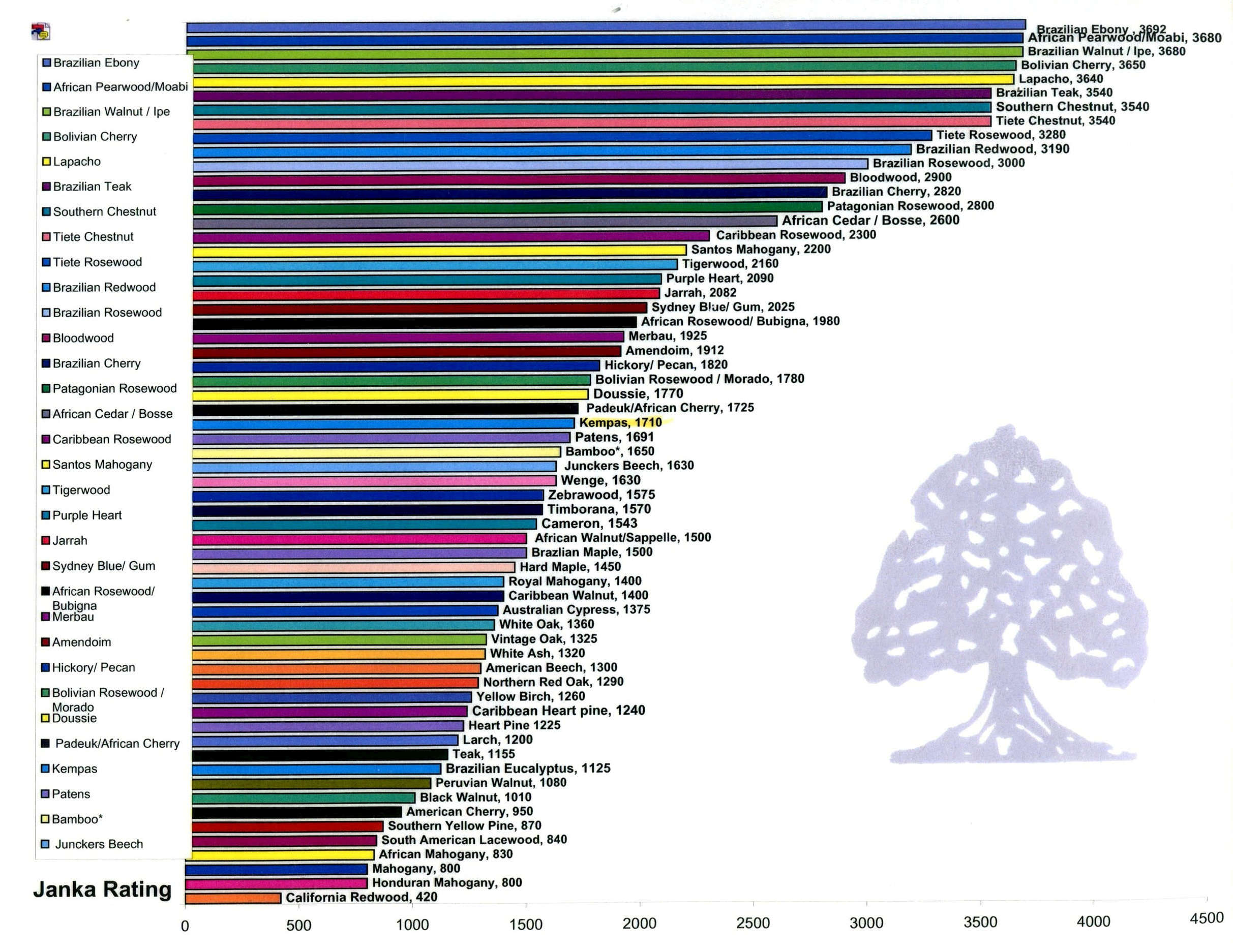Janka Hardwood Hardness Test
What Is A Janka Test?
Many of the hardwoods available here at Georgia Carpet have a section in the specifications known as the Janka Hardness or Rating. Unless you have been researching hardwood for a while, you may be wondering what this means. Is a higher or lower number better? What is the average rating for my wood choice? Luckily, Georgia Carpet wants to make sure you know exactly what you’re looking at. The Janka Test measures the force required to embed a 11.28 millimeter (0.444 inch) steel ball into wood to half its diameter. This method was chosen so that the result would leave an indention 100 square millimeters in size. It is one of the best measures of the ability of a wood species to withstand denting and wear. It is also a good indicator of how hard a species is to saw or nail. The numbers used for rating the hardness has to do with the amount of force needed. A high Janka rating means that it takes a high amount of force exerted onto the wood to dent it. It is mostly used for solid hardwood products. But what does the janka test have to do with your purchase? We have the answer! To use the janka hardness test to your advantage, you can start with determining the type of lifestyle where the flooring is going to be installed. Do you have kids? Toys can be really rough on a hardwood floor. Is it being installed in a business? Is it going to be installed in the kitchen where pots and pans will be dropped or water splashed? The type of finish has nothing to do with how well a hardwood holds up against indentation. You could have the toughest finish, like ceramic, on a pine floor, and still damage the floor just by dropping your keys on it. Scratch resistance is different from dent resistance. It's important to inquire about both the finish and the hardness. This is where the Janka test comes in. If you are looking for higher end woods like mahogany or maple, you will find that the Janka test is more relevant. Looking at an oak product, it's not the hardest species, but holds up well when pots and pans are dropped. The harder the species, the more expensive it can be. Hickory is the hardest wood species that is domestically grown and produced in America. It typically costs 20% more than red or white oak. It's a balancing act, comparing price to quality, but Georgia Carpet has distributed hardwood flooring to thousands of happy customers. We want to help you get the best discount hardwood floor species in your home or business. At Georgia Carpet, we carry many name brands of durable, hard coated hardwood floors like Mannington, Bruce, Somerset, Shaw and Homerwood.
| Wood Flooring Species | Janka Hardness |
|---|---|
| Ipe / Brazilian Walnut / Lapacho | 3684 |
| Cumaru / Brazilian Teak | 3540 |
| Ebony | 3220 |
| Brazilian Redwood / Paraju | 3190 |
| Angelim Pedra | 3040 |
| Bloodwood | 2900 |
| Red Mahogany, Turpentine | 2697 |
| Spotted Gum | 2473 |
| Brazilian Cherry / Jatoba | 2350 |
| Mesquite | 2345 |
| Santos Mahogany, Bocote, Cabreuva | 2200 |
| Pradoo | 2170 |
| Brushbox | 2135 |
| Karri | 2030 |
| Sydney Blue Gum | 2023 |
| Bubinga | 1980 |
| Cameron | 1940 |
| Tallowwood | 1933 |
| Merbau | 1925 |
| Amendoim | 1912 |
| Jarrah | 1910 |
| Purpleheart | 1860 |
| Goncalo Alves / Tigerwood | 1850 |
| Hickory / Pecan, Satinwood | 1820 |
| Afzelia / Doussie | 1810 |
| Bangkirai | 1798 |
| Rosewood | 1780 |
| African Padauk | 1725 |
| Blackwood | 1720 |
| Merbau | 1712 |
| Kempas | 1710 |
| Locust | 1700 |
| Highland Beech | 1686 |
| Wenge, Red Pine | 1630 |
| Tualang | 1624 |
| Zebrawood | 1575 |
| True Pine, Timborana | 1570 |
| Peroba | 1557 |
| Kambala | 1540 |
| Sapele / Sapelli | 1510 |
| Curupixa | 1490 |
| Sweet Birch | 1470 |
| Hard Maple / Sugar Maple | 1450 |
| Coffee Bean | 1390 |
| Natural Bamboo (represents one species) | 1380 |
| Australian Cypress | 1375 |
| White Oak | 1360 |
| Tasmanian Oak | 1350 |
| Ribbon Gum | 1349 |
| Ash (White) | 1320 |
| American Beech | 1300 |
| Red Oak (Northern) | 1290 |
| Caribbean Heart Pine | 1280 |
| Yellow Birch | 1260 |
| Movingui | 1230 |
| Heart Pine | 1225 |
| Carbonized Bamboo (represents one species) | 1180 |
| Cocobolo | 1136 |
| Brazilian Eucalyptus / Rose Gum | 1125 |
| Makore | 1100 |
| Boreal | 1023 |
| Black Walnut | 1010 |
| Teak | 1000 |
| Sakura | 995 |
| Black Cherry, Imbuia | 950 |
| Boire | 940 |
| Paper Birch | 910 |
| Cedar | 900 |
| Southern Yellow Pine (Longleaf) | 870 |
| Lacewood, Leopardwood | 840 |
| Parana | 780 |
| Sycamore | 770 |
| Shedua | 710 |
| Southern Yellow Pine (Loblolly and Shortleaf) | 690 |
| Douglas Fir | 660 |
| Larch | 590 |
| Chestnut | 540 |
| Hemlock | 500 |
| White Pine | 420 |
| Basswood | 410 |
| Eastern White Pine | 380 |
The Basics
Hardwood has remained the one of the world’s most popular floor coverings for centuries and one of the most challenging parts about deciding on what hardwood to go with is not the look of the wood, but the hardness. The term hardwood is a collective term used to describe a variety of wood species. They come from trees differing in color, moisture resistance, grain and hardness.
The Janka scale actually rates the trees by measuring hardness. This is more complex than what it may seem. The test is designed to measure the resilience of the tree species by applied force. More specifically a number is assigned to the species of wood based on how well it performs when half of a 0.444 inch steel ball is embedded into the wood’s surface.
There are variants that depend on the position of the grain and board direction during the test. These will be the deciding factor of the “side” or “end” hardness of the wood. When doing a side test score, the pound force is applied perpendicularly to the grain, and this is the number that will be given to you as the Janka score. Higher numbers mean harder wood.
Why do we test a wood’s hardness?
The whole point of the test is to measure the species resistance to denting, which is one of the most important factors when choosing the right hardwood surface for your floors. You always want to know just how your floor will handle basic wear and tear. With high traffic, pets, and children being children, you can’t go wrong with being prepared for life’s little mistakes. Even after a while, the weight of furniture can dent a floor if it does not score high on the janka scale.
When it comes to installing hardwood flooring, janka hardness can be a great indicator of the level of installation that will be required. Typically the harder the wood, the more time and energy it will take to install, as softer woods can typically be nailed easily while harder woods will require pre-drilled holes.
While all the figures are great to know, they aren’t everything.
Many people tend to depend too much on the numbers when it comes to the Janka score. It should be known that this score is not 100% accurate. It is more for a “ballpark” value than an absolute, dealbreaker hardness rating. Although the hardness of your future floors is important, factors like finish and construction will directly affect the durability of your floor. If you would like to read more about janka hardness rating and its relevance, be sure to check out our blog.



